Exhibitions
The exhibitions of the Palestinian Museum are its main interface- the most important point of interaction with the general public and the beating heart under which programmes and projects are formed. They give collections, objects, and artworks a vital dimension by placing them in conceptual contexts open to exploration.
The sustainability of the exhibitions means the sustainability of the Palestinian Museum, and the sustainability of the purpose for which it was founded: to provide emancipatory knowledge of Palestine and its people, history, and culture. The production of these exhibitions is a complex and cumulative process during which a consolidated team lifts the building blocks, one on top of the other, to eventually reach a unique structure that within its corners and narratives comprises a summary of specialised research. It presents this research to those hungry to get closer to the spirit of Palestine in its components and treasures.
The support at various levels of the museum's friends, permanent members, and donors has helped paint this picture: 11 consecutive exhibitions on Palestinian history and cultural heritage; tens of thousands of visitors since the opening of the first exhibition; and a renewed experience that brings history, art, and culture to life for each visitor, who afterwards doesn’t leave as they were.
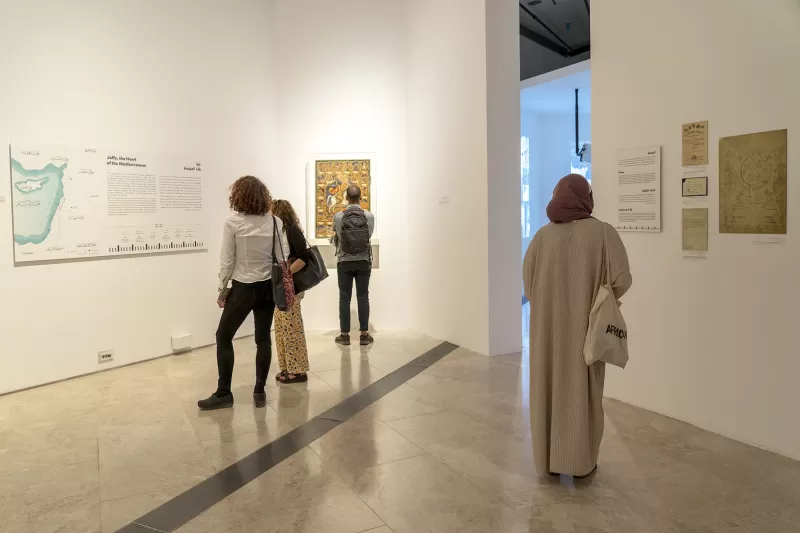
Collections
The museum's permanent collection represents the heart of the museum's work and the pillar on which it builds its exhibitions and programmes. Its preservation plays a role in preserving Palestinian heritage. It seeks to be comprehensive and representative; however, achieving this is a constructive process that requires years of effort, huge financial resources, and specialised and trained personnel to contend with preserving, documenting, processing, and making various types of objects available for display.
The museum received support to build up its permanent collection; in its acquisition, it became available to the Palestinian public everywhere through its exhibitions, programmes, and digital platforms. This generous support was given in many forms, including financial support that made possible the preparation of the collection room, the collection of artworks and pieces, and training the collections team in preservation and documentation. This support has also included direct contributions, by artists and collection owners from Palestine and many friendly countries, of their pieces, artworks, and some of their collections.
Today, the Palestinian Museum celebrates its national collection that, thanks to your donations and contributions, includes dozens of artworks ranging from paintings, installations, and sculptures; hundreds of photographs; films; recordings; ethnographic pieces, including dresses, jewellery, shawls and head coverings; hundreds of posters; documents; photographs; books; newspapers; and stamps.
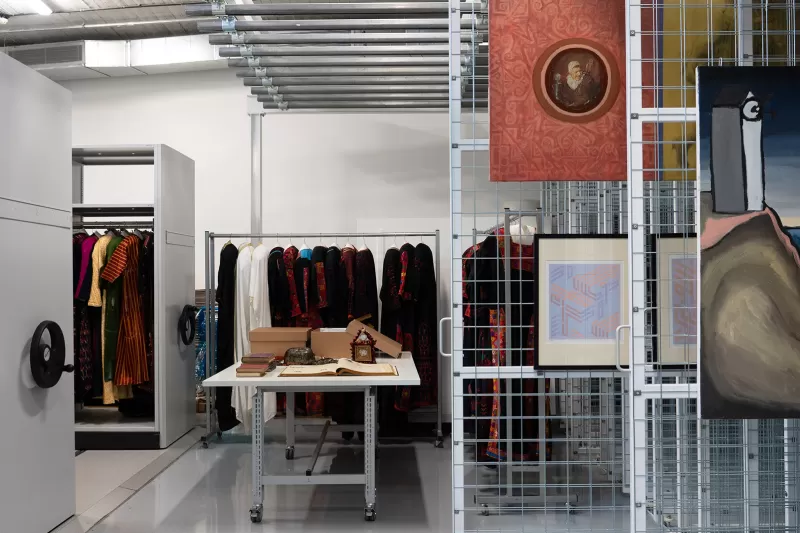
Conservation studios
The Palestinian Museum believes that its role is not only to acquire and exhibit collections and objects but to preserve endangered Palestinian tangible heritage and a diverse array of collections, including personal collections, by protecting them from the passage of time and ensuring their safety and intactness for generations. To this end, the museum established a paper-based conservation studio and another for the restoration of fabrics and textiles, thus becoming one of the first restoration-specialised studios in Palestine.
The funding of partner institutions and friends contributed to the establishment of the studios; the restoration of 5,060 paper documents (including newspapers, title deeds dating back to the Ottoman period, books, photographs, letters, and envelopes dating back to the British Mandate period, and many others); beginning restoration of several garments; and conducting a survey on pieces and ethnographic collections in need of restoration (covering 16,000 pieces, including 5,000 traditional dresses or thobes.)
This project is patriotic par excellence. It is a cumulative work in need of extensive effort and support; in the restoration of every document, garment, or piece of art, we contribute to preserving our heritage from loss and distortion, and we are closer to achieving the mission of the Palestinian Museum in producing and disseminating emancipatory knowledge experiences about Palestine and its people, culture, and history. Every act of support from you is a building block in accomplishing this mission.

The Palestinian Museum Digital Archive (PMDA)
More than 300,000 items, including photos, documents, records, sound recordings, and films, were saved from loss and damage by digitisation, archiving, and preservation by the PMDA for generations to come. Precious personal memories are brought to eternal life, and value is given to every event, story, piece, and tale. These objects are placed side by side as puzzle pieces, to illuminate, in combination, chapters of a people.
The generous support that the PMDA has received has opened the door for hundreds of individuals and institutions to pass on their experiences, lives, and personal, family, institutional, societal, and national heritage. It has paved the way for highlighting pivotal narratives within the history of the Palestinian people, by adopting the principle of ‘history from below’; archiving private and public collections across class lines; and highlighting the personal and daily impact throughout the year and the role of the individual in the collective narrative. PMDA has lifted the curtain off tales from our history, and increases geographically access to the archives of Palestinians in diaspora camps and around the world.
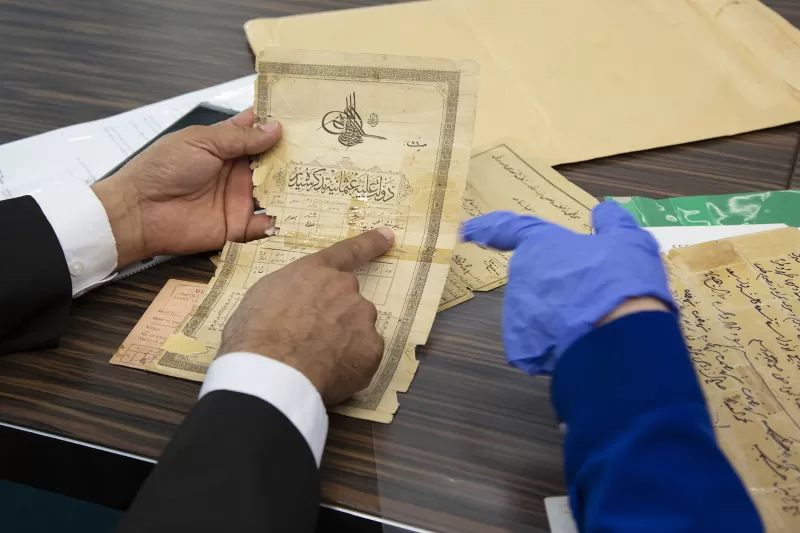
Education programme
Every moment in life can be a teachable moment!
To date, the Palestinian Museum Education Programme has made qualitative leaps in building museum knowledge tailored to children and students that is based on interactive learning and participation in creating meaning. It does so through dozens of artistic events and workshops that stimulate innovation and integrate the needs of disabled children and family educational activities, summer camps, and teacher programmes. The programme tells students that they have a place here; that in the museum, they are an integral part of building knowledge, contributors to idea expansion, and are creative, independent, and free.
We want this programme to expand and grow, the way ideas and dreams of a better future do. This is what the support of friends, members, and partners accomplishes: with each coin, a child is helped in reaching the museum; with each round of funding, the number of schools we could access doubled; and with every grant, an educational platform was created. We were enabled to work with artists and creators and create specialised publications to help fill children’s libraries in Palestine.

Public programme
The Public Programme is for the Palestinian public- its families, students, artists, researchers, academics, and intellectuals. It is a space that makes pioneering partners active in creating and testing out knowledge and in engaging in fun and exploration throughout.
In the museum’s building in Birzeit, hundreds of events, singing and other musical celebrations, artistic workshops, fascinating dialogues, tours, and theatrical and other performances have been carried out by the programme. Through live or recorded meetings and videos, tens of thousands of Palestinians in Palestine and around the world have been able to remotely participate. Each year, the programme has expanded its boundaries, attracting those with unique and authentic interests, all of whom find an opportunity to add their touches and participate in content creation.
This is made possible thanks to your generous support which opens new horizons for partnerships with creatives and content creators, who year after year provide our Palestinian society with their unique knowledge, experience, and contributions. Your support also expands the scope of our online presence, making it available to a wider audience and making us an interactive museum that provides mobile and innovative knowledge.
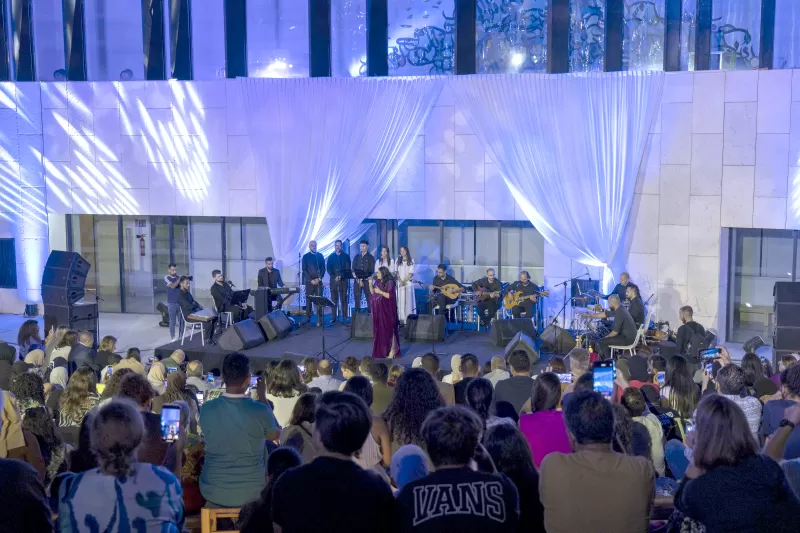
Knowledge programme
Knowledge at the Palestinian Museum is produced through a complex process of interaction between knowledge generators in Palestine, comprised of a series of panel discussions, dialogues, lectures, seminars, conferences, and research grants, and through high-level networking with cultural institutions, researchers, and academics.
The main objective of the program is to bridge knowledge gaps and shed light on what the exhibitions do not say; or rather, to cover a set of historical, humanitarian, and research facts and realities beyond the scope of the museum's exhibitions or not covered in their main statements.
Over the years, this programme has partnered with dozens of institutions, researchers, and intellectuals. It provides a real space for interaction on urgent or intractable issues and is a platform for spreading knowledge gained from networking and engaging in cultural and academic work, increasing the dissemination of narratives about the history of Palestine.
Funding, partnerships, and collaboration have so far contributed to achieving part of the programme's goals and ambitions. Still, more support is needed to expand its knowledge capacity and contribute to strengthening the status of research-based methodological knowledge and communication between student communities, cultural institutions, and those interested in and for Palestine.
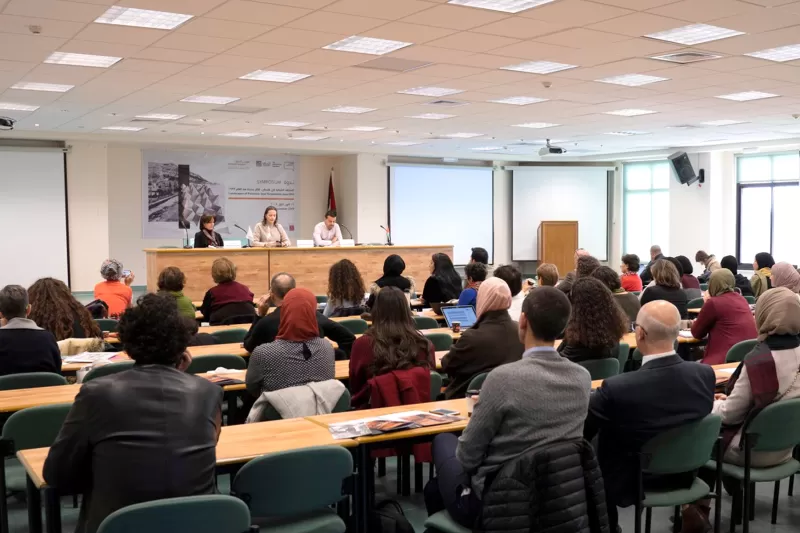
Publications
The Palestinian Museum produces knowledge on many levels and in many forms, of which its various publications are one of the most significant. Thanks to your continuous support, we have been able to produce several unique specialist publications ranging from those accompanying exhibitions, such as catalogues, guides, and publications that assist children and teachers during their tours; research and academic publications, which include contributing research papers to seminars, lectures, conferences and more; children's publications produced by the education programme in cooperation with writers and artists from Palestine and around the world; art books; annual reports; brochures; and games. Your support also contributed to the adoption of the highest quality possible in preparation, translation, editing, and design, and facilitated the work of the museum in publishing many works which serve various sectors in Palestine.
